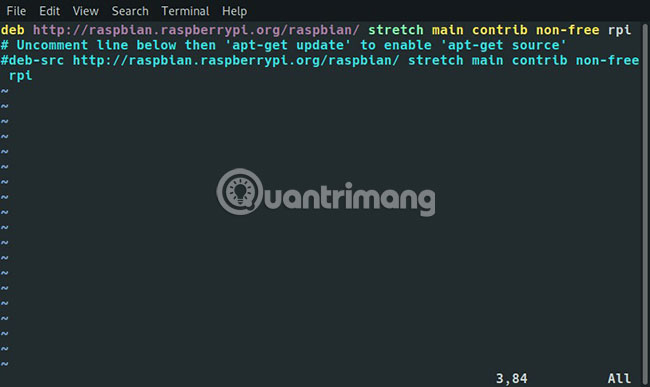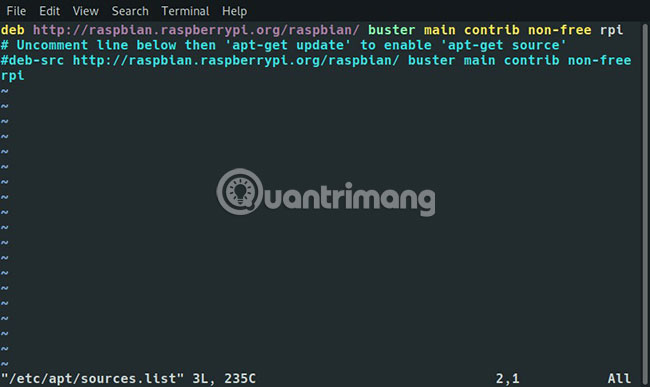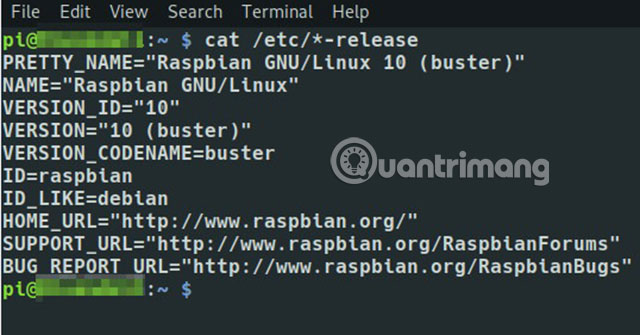How to upgrade Raspberry Pi to Raspbian Buster
Raspberry Pi 4B was first released at the end of June 2019 and comes with a new version of Raspbian, the official operating system of Raspberry Pi. Soon, Debian, the operating system based on Raspbian, has also released its latest version, Debian 10 Buster.
Thanks to the framework already from Debian, upgrading the operating system of Raspberry Pi is very simple. In addition, if you want to use the existing Raspbian installation on the new Raspberry Pi 4, you can do it once it is upgraded to Buster.
Update Pi
Before you upgrade Pi, it's good to make sure that the current Raspbian installation is completely up to date. The shorter the distance between the software versions in the upgrade, the better. Burning the stage can cause unresolved conflicts and break everything permanently. Raspbian is designed to seamlessly migrate from the Stretch installation to a fully updated Buster, so this is the best option to choose.
Access your Pi. If you have a screen, this part will be very easy. Just open a terminal. If you are running a headless Pi, you will need SSH. Windows 10 users can use the integrated OpenSSH function that the operating system provides. If you own a Mac or Linux, you can open a terminal and use SSH.
ssh pi@raspberrypi Then run an update and upgrade on Pi.
sudo apt update && sudo apt upgrade This step may take some time, depending on Pi's 'outdated' level. Confirm the package installation and wait until it is completed. When the upgrade is done, you should boot and reconnect the Pi to make sure you are running the latest kernel on the system.
sudo reboot Change the source file
When Pi has finished booting and is reconnected, you can start setting up Pi to upgrade. Raspbian, like Debian, uses a configuration file at '/etc/apt/sources.list' to control its software repositories. The file also specifies which version of the operating system to retrieve packages. So changing that file to use Buster instead of Stretch will allow Raspbian to upgrade itself.
Use Pi's Nano text editor, open source configuration.
sudo nano /etc/apt/sources.list The file will look like the image below.

Browse through the file and change the word 'Stretch' everywhere to 'Buster'. The end result will look like the image below.

Save the file and exit.
Run the update of the distro
With the edited file, you can run the update of the distro on the Raspberry Pi to download all packages and officially change to the new version, Buster. Run the command below in terminal Pi to start the process.
sudo apt update && sudo apt dist-upgrade After updating the repository and evaluating the necessary packages, the package manager will ask if you want to install new packages to effectively upgrade to the new release. Please confirm to start the upgrade.
This step will take some time, especially on the old Pi version or via a WiFi connection. Be patient and wait until everything is over. You will receive a notification when the upgrade is done.
Reboot and check
Before you can start using Raspbian Buster, you will need to restart Pi again.
sudo reboot After Pi restarts, visit it. You can run the following command to make sure you are running Buster.
cat /etc/*-release 
If your screen looks like an illustration, you are running Buster on the Raspberry Pi and everything is fully updated. Now you can seamlessly transfer the microSD memory card to the Raspberry Pi 4 or you can continue to use it normally in your current Pi with the update software.
Hope you are succesful.
You should read it
- How to start Raspberry Pi 3 from USB
- How to update your Raspberry Pi to the latest Raspbian operating system
- How to run, Raspberry Pi emulator on computer?
- Why should people try Raspberry Pi 4?
- 8 reasons to upgrade to Raspberry Pi 5
- How to add an ADC to Raspberry Pi: What you need to know
- Raspberry Pi Zero vs Model A and B, how are they different?
- What can be done with the 64-bit version of Raspberry Pi OS?
May be interested
- Debian 10 Buster, New features in Debian 10 Buster
 debian 10 buster has been released. let's explore the new features in debian 10 buster through the following article!
debian 10 buster has been released. let's explore the new features in debian 10 buster through the following article! - How to connect Raspberry Pi remotely to a Windows computer
 perhaps you need to check your email or some other application that you can only access on your pc. therefore, you will need to configure a remote connection for your raspberry pi.
perhaps you need to check your email or some other application that you can only access on your pc. therefore, you will need to configure a remote connection for your raspberry pi. - This cheap official Raspberry Pi upgrade is a game changer
 on may 14, 2024, the raspberry pi foundation announced the m.2 hat+, a board that can be used to add m.2 peripherals such as nvme storage and ai accelerators to the raspberry pi 5.
on may 14, 2024, the raspberry pi foundation announced the m.2 hat+, a board that can be used to add m.2 peripherals such as nvme storage and ai accelerators to the raspberry pi 5. - How to create custom shortcut keys for Raspberry Pi
 in windows, it's easy to use custom keystrokes to open your favorite apps, but in raspbian, the official operating system of the raspberry pi, the process is a bit more complicated.
in windows, it's easy to use custom keystrokes to open your favorite apps, but in raspbian, the official operating system of the raspberry pi, the process is a bit more complicated. - How to turn Raspberry Pi into a personal cloud server
 in this tutorial, we will show you how to turn your raspberry pi into a personal cloud server. before proceeding, make sure you've booted up your pi, have a mouse and keyboard connected, and finally the raspbian operating system installed on it.
in this tutorial, we will show you how to turn your raspberry pi into a personal cloud server. before proceeding, make sure you've booted up your pi, have a mouse and keyboard connected, and finally the raspbian operating system installed on it. - Instructions on 2 ways to install MongoDB on Raspberry Pi
 in this tutorial, tipsmake will guide you through the process of installing and setting up the mongodb server software on your raspberry pi.
in this tutorial, tipsmake will guide you through the process of installing and setting up the mongodb server software on your raspberry pi. - How to use DietPi on the Raspberry Pi
 dietpi is even lighter than the raspbian lite and it's optimized to impact the pi hardware as little as possible. however, dietpi possesses a remarkable strength
dietpi is even lighter than the raspbian lite and it's optimized to impact the pi hardware as little as possible. however, dietpi possesses a remarkable strength - How to add an ADC to Raspberry Pi: What you need to know
 raspberry pi lacks analog input. this puts it at a disadvantage compared to microcontroller-based boards like the arduino.
raspberry pi lacks analog input. this puts it at a disadvantage compared to microcontroller-based boards like the arduino. - Raspberry Pi Zero vs Model A and B, how are they different?
 you want to buy a raspberry pi, but when you search, you have a problem: why are there so many raspberry pi models? although all of the different raspberry pi can do many similar tasks, there are tasks that specific boards will be more suitable for.
you want to buy a raspberry pi, but when you search, you have a problem: why are there so many raspberry pi models? although all of the different raspberry pi can do many similar tasks, there are tasks that specific boards will be more suitable for. - How to install Java on a Raspberry Pi
 there are two different java implementations, oracle java and openjdk. this tutorial explains how to install java (openjdk) on a raspberry pi with the latest raspbian operating system running on it.
there are two different java implementations, oracle java and openjdk. this tutorial explains how to install java (openjdk) on a raspberry pi with the latest raspbian operating system running on it.










 11 classic Raspberry Pi games run without emulators
11 classic Raspberry Pi games run without emulators How to dual-boot Raspberry Pi with BerryBoot
How to dual-boot Raspberry Pi with BerryBoot Why should people try Raspberry Pi 4?
Why should people try Raspberry Pi 4? How to cool Raspberry Pi
How to cool Raspberry Pi How to set up Home VPN Server with Raspberry Pi
How to set up Home VPN Server with Raspberry Pi How to set up Raspberry Pi
How to set up Raspberry Pi